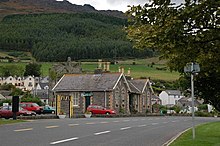| This article needs additional citations for verification. Please help improve this article by adding citations to reliable sources. Unsourced material may be challenged and removed. Find sources: "Dundalk, Newry and Greenore Railway" – news · newspapers · books · scholar · JSTOR (October 2016) (Learn how and when to remove this message) |
 | |
| Overview | |
|---|---|
| Dates of operation | 1873 (1873)–1951 (1951) |
| Technical | |
| Track gauge | 5 ft 3 in (1,600 mm) |

| Dundalk, Newry and Greenore Railway |
|---|
| Legend |


The 26 miles (42 km) Dundalk, Newry and Greenore Railway (DNGR, DN&GR) was an Irish gauge (1,600 mm (5 ft 3 in)) railway in Ireland. It was conceived as the Dundalk and Greenore Railway in the 1860s to provide a link between the towns in its title and the London and North Western Railway port at Greenore, from where a ferry service operated to Holyhead. It was opened between Greenore and Dundalk in 1873 and extended to Newry in 1876. The company operated a hotel at Greenore.
Ownership
United Kingdom legislation| Dundalk and Greenore Railway Act 1863 | |
|---|---|
| Act of Parliament | |
 Parliament of the United Kingdom Parliament of the United Kingdom | |
| Long title | An Act for making a Railway from the Irish North-western Railway at Dundalk to Greenore in the County of Louth; and for other Purposes. |
| Citation | 26 & 27 Vict. c. ccxxxiii |
| Dates | |
| Royal assent | 28 July 1863 |
| Text of statute as originally enacted | |
| Dundalk and Greenore Railway Act 1867 | |
|---|---|
| Act of Parliament | |
 Parliament of the United Kingdom Parliament of the United Kingdom | |
| Citation | 30 & 31 Vict. c. clxxxiii |
| Dates | |
| Royal assent | 12 August 1867 |
| Text of statute as originally enacted | |
| Dundalk and Greenore Railway Act 1869 | |
|---|---|
| Act of Parliament | |
 Parliament of the United Kingdom Parliament of the United Kingdom | |
| Citation | 32 & 33 Vict. c. cxxxii |
| Dates | |
| Royal assent | 26 July 1869 |
| Text of statute as originally enacted | |
| Dundalk, Newry and Greenore Railway Act 1873 | |
|---|---|
| Act of Parliament | |
 Parliament of the United Kingdom Parliament of the United Kingdom | |
| Citation | 36 & 37 Vict. c. clxxiv |
| Dates | |
| Royal assent | 21 July 1873 |
| Text of statute as originally enacted | |
The London and North Western Railway owned the railway and at first provided its locomotives and rolling stock, with the locomotives coming from its Crewe Works. The railway passed to the London, Midland and Scottish Railway in 1923 but an agreement was reached in 1933 for the line to be worked by the Great Northern Railway. Because the partition of Ireland placed an international frontier across the DN&G's Greenore – Newry line, it was not absorbed into either the Great Southern Railways in 1925 or the Ulster Transport Authority in 1948.
Closure
The line was closed on 31 December 1951 and was dissolved in 1957 by the British Transport Commission Act 1957 (5 & 6 Eliz. 2. c. xxxiii). In recent years, much of the line has been restored as part of the Carlingford to Omeath Greenway between Newry and Carlingford.
Preservation

One six-wheeled coach, DNGR No. 1 built in 1909, a composite with a coupé compartment, has been preserved at the Ulster Folk and Transport Museum, Cultra.
Consideration was given to the preservation of locomotive No.1 Macrory but, in the end, no locomotives were preserved. It is believed that this was because of an ill-informed belief among those in charge of its fate that the locomotive was of a different track gauge to the rest of Ireland, due to the fact that it was built and owned by a British company, although this was not the case. All of the locomotive nameplates have been preserved.
However, a GNR 2-4-2T JT class locomotive, No. 93, which worked on the DNGR line under GNR operation, has also been preserved and is displayed with the DNGR coach in Cultra.
See also
- Locomotives of the Dundalk, Newry and Greenore Railway
- Newry, Warrenpoint and Rostrevor Railway - which ran on the other side of Carlingford Lough
References
- "Carlingford - Omeath Greenway Greenway". The Argus. 18 June 2014. Retrieved 1 January 2015 – via Independent.ie.
- "The Carlingford Lough Greenway - Phase 1 Completed". newrymournedown.org. Newry, Mourne and Down District Council. Retrieved 29 May 2020.
Louth County Council has already constructed 6.2km of Greenway from Omeath to Carlingford Marina and this opened in 2014
- "Dundalk Newry Greenore 1 First/Second Composite built 1909". www.cs.vintagecarriagestrust.org. Retrieved 26 July 2016.
Further reading
- Barrie, D.S.M. (1980) . The Dundalk, Newry and Greenore Railway. Oakwood Library of Railway History. Lingfield: Oakwood Press. ISBN 0-85361-260-9.
External links
- Dundalk, Newry and Greenore Railway history - irishrailwayana.com